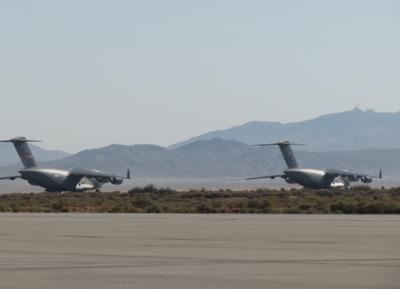Early Testing Shows A 10 Percent Jump In Fuel Economy
Migrating birds, NASCAR drivers and Tour de France bicyclists already get it. And now the Air Force is thinking about flying gas-guzzling cargo aircraft in formation -- 'dragging' off one another -- on long-haul flights across the oceans. Flight tests with C-17s "vortex surfing" at Edwards Air Force Base, CA, Sept. 6 and Oct. 2, have demonstrated potentially large savings of fuel and money by doing what geese do naturally. Tests show that flying in formation might be smarter than flying alone for Airmen, and not just for birds.

As one effort in the Air Force drive to reduce its overall fuel consumption, vortex surfing may be the wave of the future. "The concept, formally known as Surfing Aircraft Vortices for Energy, or $AVE, involves two or more aircraft flying together for a reduced drag effect like what you see with a flock of geese," said Dr. Donald Erbschloe, the Air Mobility Command chief scientist.
A series of test flights involving two aircraft at a time, allowed the trailing aircraft to "surf" the vortex of the lead aircraft, positioning itself in the updraft to get additional lift without burning extra fuel. Early indications from the tests promise a reduction of fuel consumption by up to 10 percent for the duration of a flight. Over long distances and with even a small fraction of Air Mobility Command's average of more than 80,000 flights a year, the fuel and cost savings could reach into the millions of dollars, experts say.
The Air Force Research Laboratory next will analyze the data from for possible applications to other aircraft on a variety of missions. Dr. Erbschloe said larger air mobility aircraft like the C-17 can fly in formations that are potentially easy to maintain and which do not require the planes to be exceptionally close together. "The test flights were flown at longitudinal separations of 4,000 or greater," said William Blake, one of the key developers of $AVE at the AFRL.
According to AFRL officials, modified C-17 formation flight system software enabled precise auto-pilot and auto-throttle systems to ensure the trailing aircraft achieved and maintained proper flight position without active assistance from pilots. "The autopilot held the position extremely well -- even close to the vortex," said Capt. Zachary Schaffer, an aircraft commander on one of the test flights. "The flight conditions were very safe; this was as hands-off as any current formation flying we do."
Other pilots found differing levels of ride quality and discovered some flight test points might be difficult for long-endurance flights. "The key will be finding the right balance of quality for improving fuel efficiency and ride," said Maj. Eric Bippert, another aircraft commander on one of the test flights.
Bippert said being a part of the test program with so many talented engineers was a remarkable experience, and the concept could eventually impact global air transportation, overall. "AMC has done really well with fuel efficiency at the operational level," said Erbschloe. "The command has worked to gain efficiencies from the 'low-hanging fruit' such as optimizing flight routing, reducing weight where possible, and by not carrying excess fuel. $AVE offers significant efficiency gains, if employed in concert with these initiatives."

He said early indications show the tests meet AMC criteria of the concept regarding safety and minimization of aircrew and aircraft strain while also being operationally sensible with a viable return on investment. "AMC consumes 20 percent of the fuel used by the overall federal government, so we're constantly looking for pragmatic ways to improve our fuel efficiency," said Erbschloe.
"Assured energy advantage for our Air Force is only possible through revolutionary energy initiatives like $AVE," said Dr. Mark Maybury, Air Force chief scientist, upon hearing the results of the tests.
The $AVE concept was previously highlighted in the 2011 Energy Horizons study, sponsored by the Secretary of the Air Force and chaired by Maybury. The tests were the culmination of an ongoing, combined effort between AMC, the AFRL, the 412th Test Wing, the Air Force Life Cycle Management Center, the Defense Advanced Research Projects Agency, the Boeing Company and NASA Dryden Flight Research Center.
(USAF images)
 ANN's Daily Aero-Term (04.26.24): DETRESFA (Distress Phrase)
ANN's Daily Aero-Term (04.26.24): DETRESFA (Distress Phrase) Aero-News: Quote of the Day (04.26.24)
Aero-News: Quote of the Day (04.26.24) ANN's Daily Aero-Term (04.27.24): Direct
ANN's Daily Aero-Term (04.27.24): Direct ANN's Daily Aero-Linx (04.27.24)
ANN's Daily Aero-Linx (04.27.24) Aero-News: Quote of the Day (04.27.24)
Aero-News: Quote of the Day (04.27.24)




